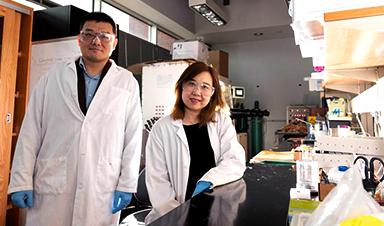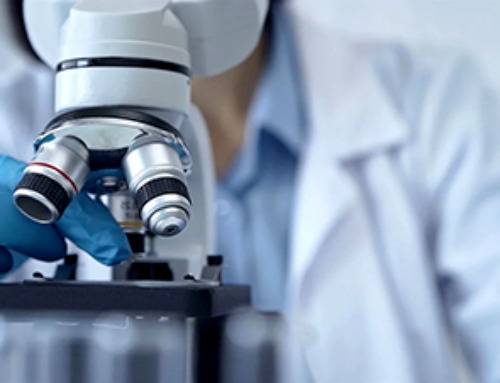In a first-of-its-kind study, researchers used an ingenious experimental setup and high-energy X-ray beams to observe a high-temperature, high-pressure chemical reaction to establish how the formation of two varied nanoscale crystalline structures in the metal cobalt is controlled.
The method enabled continuous analysis of cobalt nanoparticles as they formed from clusters that include tens of atoms to large crystals measuring 5 nm.
The study offers the proof-of-principle for a novel method to analyze the real-time formation of crystals, with prospective applications for other materials, such as oxides and alloys. The study data created “nanometric phase diagrams” that revealed the conditions controlling the structure of cobalt nanocrystals as they grew.
Published in the Journal of the American Chemical Society on November 13th, 2018, the study applied the U.S. Department of Energy-supported synchrotron X-ray beam lines at Argonne National Laboratory and Brookhaven National Laboratory. It was sponsored by the National Science Foundation.
Crystal formation in bulk cobalt prefers the hexagonal close-pack, or HCP, structure since it reduces energy to produce a stable structure. However, at the nanoscale, cobalt also tends to form the face-centered cubic, or FCC, phase, which possesses a higher energy. That can be stable because the total crystalline energy is affected by the high surface energy of tiny nanoclusters, Chen informed.
“When the clusters are small, we have more tuning effects, which is controlled by the surface energy of the OH minus group or other ligands,” he added. “We can tune the concentration of the OH minus group in the solution so we can tune the surface energy and therefore the overall energy of the cluster.”
In association with scientists from the Department of Materials Science at the University of Maryland and the two national laboratories, Chen and Xuetian Ma, a graduate research assistant, studied the polymorphic structures using experimental, theoretical, and computational modeling methods.
Image Credit: Allison Carter, Georgia Tech
News This Week
Lingering Viral Fragments: The Hidden Cause of Long COVID
Long COVID, affecting 5-10% of COVID-19 patients, might be caused by the enduring presence of the virus in the body. Research suggests that viral fragments, possibly live, linger and lead to symptoms. Addressing this involves antiviral treatments, enhanced [...]
Hidden Scars: How COVID Lockdowns Altered Teen Brains Forever
Research from the University of Washington revealed that COVID-19 lockdowns led to accelerated cortical thinning in adolescents, impacting brain development significantly. This effect was more pronounced in females than males, raising concerns about long-term brain health. The study [...]
Simple Blood Test To Detect Dementia Before Symptoms Appear
UCLA researchers have identified placental growth factor (PlGF) as a potential blood biomarker for early detection of cognitive impairment and dementia. High PlGF levels correlate with increased vascular permeability, suggesting its role in the development [...]
Investing Goldman Sachs asks ‘Is curing patients a sustainable business model?’
Goldman Sachs analysts attempted to address a touchy subject for biotech companies, especially those involved in the pioneering “gene therapy” treatment: cures could be bad for business in the long run. “Is curing patients [...]
The risks of reversed chirality: Study highlights dangers of mirror organisms
A groundbreaking study evaluates the feasibility, risks, and ethical considerations of creating mirror bacteria with reversed chirality, highlighting potential threats to health and ecosystems. In a recent study published in Science, a team of researchers [...]
Alarming Mutation in H5N1 Virus Raises Pandemic Red Flags
NIH-funded study concludes that the risk of human infection remains low A recent study published in Science and funded by the National Institutes of Health (NIH) has found that a single alteration in a protein on the surface [...]
Scientists Discover Genetic Changes Linked to Autism, Schizophrenia
The Tbx1 gene influences brain volume and social behavior in autism and schizophrenia, with its deficiency linked to amygdala shrinkage and impaired social incentive evaluation. A study published in Molecular Psychiatry has linked changes in brain [...]
How much permafrost will melt this century, and where will its carbon go?
Among the many things global warming will be melting this century—sea ice, land glaciers and tourist businesses in seaside towns across the world—is permafrost. Lying underneath 15% of the northern hemisphere, permafrost consists of [...]
A Physics Discovery So Strange It’s Changing Quantum Theory
MIT physicists surprised to discover electrons in pentalayer graphene can exhibit fractional charge. New theoretical research from MIT physicists explains how it could work, suggesting that electron interactions in confined two-dimensional spaces lead to novel quantum states, [...]
Inside the Nano-Universe: New 3D X-Ray Imaging Transforms Material Science
A cutting-edge X-ray method reveals the 3D orientation of nanoscale material structures, offering fresh insights into their functionality. Researchers at the Swiss Light Source (SLS) have developed a groundbreaking technique called X-ray linear dichroic orientation tomography [...]
X-chromosome study reveals hidden genetic links to Alzheimer’s disease
Despite decades of research, the X-chromosome’s impact on Alzheimer’s was largely ignored until now. Explore how seven newly discovered genetic loci could revolutionize our understanding of the disease. Conventional investigations of the genetic contributors [...]
The Unresolved Puzzle of Long COVID: 30% of Young People Still Suffer After Two Years
A UCL study found that 70% of young people with long Covid recovered within 24 months, but recovery was less likely among older teenagers, females, and those from deprived backgrounds. Researchers emphasized the need [...]
Needle-Free: New Nano-Vaccine Effective Against All COVID-19 Variants
A new nano-vaccine developed by TAU and the University of Lisbon offers a needle-free, room-temperature-storable solution against COVID-19, targeting all key variants effectively. Professor Ronit Satchi-Fainaro’s lab at Tel Aviv University’s Faculty of Medical and [...]
Photoacoustic PDA-ICG Nanoprobe for Detecting Senescent Cells in Cancer
A study in Scientific Reports evaluated a photoacoustic polydopamine-indocyanine green (PDA-ICG) nanoprobe for detecting senescent cells. Senescent cells play a role in tumor progression and therapeutic resistance, with potential adverse effects such as inflammation and tissue [...]
How Dysregulated Cell Signaling Causes Disease
Cell signaling is crucial for cells to communicate and function correctly. Disruptions in these pathways, caused by genetic mutations or environmental factors, can lead to uncontrolled cell growth, improper immune responses, or errors in [...]
Scientists Develop Super-Strong, Eco-Friendly Plastic That Bacteria Can Eat
Researchers at the Weizmann Institute have developed a biodegradable composite material that could play a significant role in addressing the global plastic waste crisis. Billions of tons of plastic waste clutter our planet. Most [...]























Leave A Comment